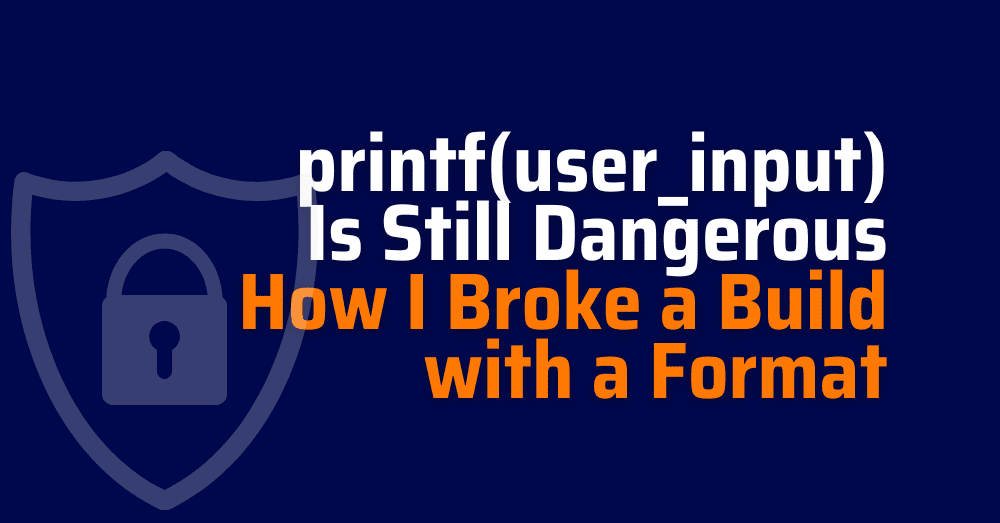What Are Format String Bugs?
Format string bugs occur when unvalidated Python user input is passed into formatting functions like printf, System.out.printf, or Python’s f-strings and logging methods. These functions interpret format specifiers (like %s, %x, etc.) in the string. If the string is under user control, this can lead to crashes or security issues.
So when we say printf(user_input), we’re warning against giving untrusted Python user input control over powerful formatters.
Real-World Setup: printf(user_input) in a Python App
A developer added a seemingly harmless debug statement using printf(user_input) inside a Python script. That commit passed code review and was picked up by the CI pipeline. During execution, the formatter encountered Python user input with unexpected tokens, causing corrupted output and a build failure.
CI Log (excerpt):
TypeError: format expected … got … No malicious input, just a formatting assumption gone wrong. Because printf interprets structure, the pipeline collapsed on what looked like routine input.
The Trap in Plain Sight: Why printf(user_input) Still Happens in 2025
Despite format string vulnerabilities dating back to C, they remain a problem today. Fast-paced development often involves copying snippets from Stack Overflow or internal tools. A line like printf(userInput) or print(f”{user_input}”) seems harmless, but it isn’t.
Even modern CVEs show real-world consequences. Take CVE-2023-21930 as an example: a format string vulnerability in a widely-used Java printf implementation allowed attackers to cause application crashes or read sensitive memory. Or CVE-2023-36052, affecting a logging system where user-controlled format strings led to log corruption.
These are not edge-case issues; they affect modern, actively maintained libraries and systems. Modern language features like f-strings and template literals make formatting easier but also hide complexity. Used carelessly, they can crash services or expose logic.
These bugs don’t only exist in legacy apps. We’ve seen them in open-source CI scripts, init logs, and even security tools built with modern stacks like Python, Java printf, and Node.js.
Bottom line: printf(user_input) isn’t just bad style, it’s a real risk.
Anatomy of the Vulnerability: What printf(user_input) Does
At face value, printf(user_input) just prints a string. But under the hood, it interprets it as a series of instructions.
Across Python, Java, and Node.js, the pattern is the same: format functions parse input for tokens like %s, %x, or {}. If the input string comes from the user and hasn’t been validated, those tokens act like commands. This can lead to crashes, corrupted logs, or security issues.
Even worse, many libraries and wrappers abstract the formatting step, so the vulnerability can be hidden deep in utility functions or logging tools. You might think you’re just logging text, but untrusted tokens from Python user input or Java printf can quietly break your application.
The takeaway: Formatting functions aren’t just about output; they interpret structure. If you let the user input define that structure, you risk instability and compromise.
Real Risk in the Pipeline: From Innocent Commit to Build Outage
It starts with a small commit: a log statement using printf(user_input).
CI picks up the change, executes it, and boom, logs are corrupted, output is misaligned, tests are unreadable. Just one unvalidated Python user input with formatting tokens was enough to collapse the pipeline.
CI/CD Flow:
- Dev commits code with printf(user_input)
- CI job runs, processing user-controlled input
- Formatter misinterprets string → crash or broken output
- Build fails, delaying deployment and increasing debugging time
This isn’t theory; we’ve seen it play out in modern environments.
Not Just Legacy: Why Format Bugs Still Matter Today
Format string bugs aren’t relics; they’ve evolved. Python, Java, and Node.js all support rich formatting tools. And modern development habits often mean Python user input flows unchecked into these tools.
Why It Still Happens Speed. Intuition. A junior dev might write print(f”{user_input}”) without thinking. Same for System.out.printf(userInput) in Java.
CVEs Keep Coming. Recent security advisories highlight format string issues in modern ecosystems. Vulnerabilities like CVE-2023-21930 (Java printf) and CVE-2023-36052 (logging framework) show how unvalidated format strings in contemporary environments can still lead to crashes or data leakage.
CI/CD Alone Isn’t Enough. CI often checks syntax and lint rules, but not unsafe format string use. That leaves a critical gap.
Spotting the Landmines: Modern Detection of Format String Issues
These bugs are easy to write and hard to detect.
Your IDE Probably Won’t Save You: VS Code, PyCharm, IntelliJ, while great for many errors, they don’t typically track data flow between input sources and format functions. Dropping printf(user_input) or System.out.printf(userInput) into your code won’t raise alarms, because IDEs assume you’re in control of the string being formatted.
Linters Don’t Catch It Either. Popular linters like flake8, pylint, or eslint focus on syntax, styling, and conventional bugs. Unless specifically configured, they won’t understand that user_input might come from an external or untrusted source. A GitHub Action running standard lint rules will likely give you a green checkmark, even if you’ve introduced a dangerous format string.
Where SAST Comes In: Static Application Security Testing (SAST) is uniquely suited to this problem because it follows data flow through your codebase. A good SAST tool can:
- Track data from untrusted sources (e.g., Python user input, environment variables, CLI args)
- Identify when that data flows into sensitive sinks like formatting functions (printf, System.out.printf, f-strings)
- Flag unsafe paths and generate actionable alerts, even if the risky line is buried inside a helper method or wrapper class
- Support custom rules or policies to block printf(user_input)-like patterns at scale
SAST helps shift left: it catches format bugs during development or CI before they can cause runtime issues or security incidents.
TL;DR: Guardrails > Manual Review Fast-moving teams need SAST to act as a safety net, one that understands context, follows input flow, and blocks dangerous formatting before merge.
Guardrails That Work: Preventing Format-Driven Failures
Start with Static Checks in CI Use tools that:
- Analyze data flow from input to formatter
- Block merges on unsafe printf use
- Add pre-commit hooks for format string patterns
Stop Using Raw printf(user_input) Use safer patterns:
In Python
logging.info("%s", user_input) # Safe
Avoid:
print(f"{user_input}") # RiskyIn Java
MessageFormat.format("{0}", userInput) // Safe
Or sanitize inputs if using System.out.printf.Wrap Your Format Logic: Create internal wrappers that:
- Reject untrusted format strings
- Log with templates
- Are testable and auditable
Don’t Rely on Culture, Automate It. Train your team, but back it with CI enforcement and SAST.
DevSecOps in Action: How Xygeni Stops Format Bugs Before They Deploy
Format Bugs Caught Where It Matters: In CI, Xygeni actively scans repositories for dangerous formatting patterns such as:
- printf(user_input) in Python
- System.out.printf(userInput) in Java
These are flagged as high-risk because they allow Python user input and Java printf misuse to define behavior in formatting engines.
Real-Time Blocking Across CI Providers. When integrated with GitHub Actions, GitLab CI/CD, Bitbucket Pipelines, or Jenkins, Xygeni stops the merge before the code can go live. The developer receives an immediate, contextual alert showing:
- The exact file and line where the vulnerability appears
- A clear explanation of the issue (e.g., “unvalidated input in format string”)
- Recommended actions to remediate it
This early blocking turns Xygeni from a reporting tool into a merge gatekeeper. Instead of postmortem alerts or vague findings, you get enforceable security rules at the moment it matters most.
Context-Aware Scanning: Unlike keyword searches, Xygeni analyzes data flow to understand whether format strings originate from Python user input. It can distinguish between safe internal strings and those that carry external data.
Why This Matters: Developers don’t need more noise. They need smart, actionable tools. Xygeni offers precise detection and enforces real-time guardrails where they count, in your CI pipeline. Check it out!
TL;DR – Small Bug, Big Mess: Don’t printf(user_input)
This one line can:
- Break CI
- Corrupt logs
- Cause runtime exceptions
And it’s still showing up in 2025.
The Real Risks
| Risk | Why It Happens | How to Fix It |
|---|---|---|
| CI builds and logs break | Format tokens disrupt output | Avoid direct printf(user_input) |
| Modern stacks are still vulnerable | Misused format calls in Java/Python | Sanitize input or use safer APIs |
| IDEs and linters miss it | They don’t track data flow | Use SAST tools |
| Dangerous code gets merged | Reviews can miss format flaws | Use tools like Xygeni in CI |
Developer Checklist
- Don’t pass user input directly into format strings
- Sanitize or escape user input
- Use safe methods:
- Python: logging.info(“%s”, user_input)
- Java: MessageFormat.format()
- Use a SAST tool that understands input flow
- Enforce guardrails in CI
Final Word: This isn’t about paranoia; it’s preparedness. Format bugs are easy to introduce and damaging if overlooked. Stop them before they land.

